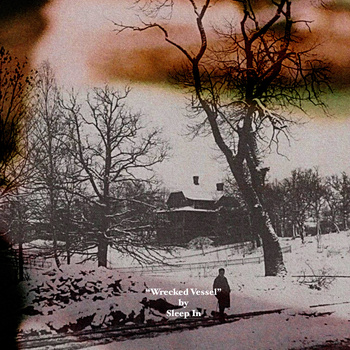The simple thing to say is that there’s another Sleep In album out, but I’ve written so many reviews for so many records created by Hamish Duncan that I’ve run aground on how to begin this review. I’d recount his musical history, but the pace at which Duncan releases material makes the mere act of writing his history a little pointless. Instead it feels more appropriate to live in real time, so I think I will: there’s a new Sleep In album, it’s called Wrecked Vessel and it’s rather good.
With previous Sleep In releases I found myself using simple tags in an attempt to summarize the overall sound of the album, like “acoustic” and “metal.” But the simple tags only went so far, and generally didn’t do justice to the often many styles Duncan would dabble in over the course of forty minutes or so. With Wrecked Vessel there’s no such luck – if anything you could call this his “wildcard album,” but as accurate as that description seems at first, again, it’s not entirely descriptive of the music here.
The term “wildcard” is in itself a rather surprising term to use for Duncan’s music to begin with, as he’s been taking left turns since his first album. His musical style always seems always seems to be evolving, but he still seems to have a certain niche sound no matter what way he goes about making his albums, or what instrument he puts in the foreground. On Wrecked Vessel the customary Sleep In sound is the guitar-driven rock numbers with plenty of big drum sounds driving them forward. And after executing these tracks rather well, albeit a little hushed and restrained, on Under Earth, it’s almost a pleasure to hear him having another go, and a further delight to see that the results are better.
Lead single “She’s The Day” is a prime example that has cymbals crashing and fuzzy guitars going at it full force as Duncan sings in his monotonous deadpan voice. With every release Duncan sounds like he’s turned up the amplifiers another notch, and if anything he’s put it up an extra few here. The guitars are fuzzy and distorted, but only because that’s the sound they’ve been intended to create. Quite possibly for the first time it sounds like Duncan has a whole band behind him, or at least a real drum set. The improved and refined drum sound helps add a new quality to the average Sleep In track that I never thought to pine after – momentum.
And this momentum makes for some of the most enjoyable and, well, awesome Sleep In tracks put to record. “To Call My Own” and “YKE” get by with simple riffs and effective percussion that seem short and sweet on the first few listens, but soon enough have you coming back. “Landslide / Throne” and “Zero King” are even briefer instrumental numbers that ideally would be part of something bigger but are enjoyable in themselves and remind you at various points how much Duncan obviously loves just rocking out.
So where does this “wildcard” tag come into all this? I’ll be frank: at first the album comes off rather scattershot, like a collection of different ideas as opposed to a cohesive album. The best tracks make themselves obvious from the beginning – “To Call My Own,” “YKE” ,the industrial and chugging “Too Tall” – and other tracks come off a rather experimental in comparison. Opening track “Danse” seems a relatively subdued affair to begin with as it nurses some light organ notes over some hiss before throwing in some juxtaposing clattering percussion and drowned single notes, while closing track “Happy, Healthy” becomes a bobbing piano number with a trip-hop beat behind it. They might not sound overly interesting, or like they should work, but these tracks make for interesting listens. “Happy, Healthy” has especially come to catch my attention as it swirls forgotten film soundtrack snippets in and out of the frame. And there are other tracks which take a little more time but are worth consideration, like the undulating “Strange Season,” and the 90s slow-grunge of “Something To Hide,” which, instead of lounging about for three and half minutes, decides to up the force and add more guitar and warped vocals into the mix.
There are some which don’t seem to work despite their best efforts: “On The Same Body” offers some curious percussion and jangly guitar but fails to stick in your head otherwise, “Time” does serve as an apt and ambling introduction into the album’s varied offerings and the doomy riffs are a noticeable and textured touch, but it can very easily sound uncomfortable, like it’s not sure where exactly to go.
Thankfully moments like these feel few once you’ve let the album settle. And that’s what feels key here – letting the album kick in. As I said, it seems to take a good few listens but soon the album feels like a cohesive unit, while strangely managing to sound like a bit of a grab bag at the same time. The album is an odd case; there’s no clunky seven minute track, yet there’s no inherent core sound or theme running through the album; there are no tracks that have Duncan refining himself altogether, but he still sounds fresh and exciting. A fault I could put to the album, then, is that I’m not sure where it leaves me as the listener. But I suppose the best thing to do in this case is just sit back and enjoy it. If there’s anything I’m sure of, it’s that Duncan will be back before long giving us something else to get our teeth into.

